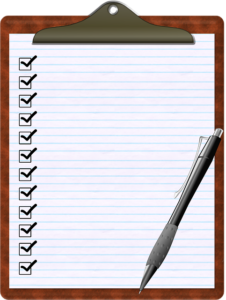This post may contain affiliate links and I may earn a small commission when you click on the links at no additional cost to you. As an Amazon Affiliate I earn from qualifying purchases. You can read my full disclaimer here.

Hopefully you have been enjoying the previous posts about debt pitfalls we need to avoid and how to start budgeting. In this post, I want to discuss 15 categories to include your budget.
If you have started budgeting, you are probably feeling one of two things. You are either elated that for the first time you know where all your money is going or you are feeling frustrated that the allocations don’t seem to be right and you can’t make it work.
Have no fear! This is normal and just means that you are ready to take it to the next level.
15 Categories to Include in Your Budget
The entire purpose of creating a budget is to tell your money where you want it to go. It is important to think ahead about expenses that will show up in the future so that you aren’t taken by surprise.
You will eventually want to look for ways to save more money so that you can get an emergency fund built up and start paying down that pesky debt.
There isn’t one right way to put together the budget and there isn’t a hard, set rule about how much to spend on something. While I am not an expert, these are some guidelines I have put together from research and personal experience.
1. Giving – 10%
The first category to include in your budget is giving. It might seem crazy to put this at the top of the list, but it is important to be generous. As a Christian, I believe in tithing. This means that 10% of my income will go to my church. No matter what religion you are (or aren’t), generosity needs to be a way of life.
2. Savings – 10%
By putting savings towards the top of the list, it is like you are making it a priority to pay yourself every month. If you wait until the end of your budget to see what you will have left, there will be nothing for this category.
Not to be harsh, but if you have succumbed to the debt pitfalls, you have probably not been saving any money. This is a huge step towards getting you on the right track.
3. Housing – 25%
This is a given. You will need somewhere to live. Dave Ramsey recommends spending no more than 25% of your income on housing. This can be a huge income drain.
If you are renting, it will easy to see how much you are spending and you probably won’t have additional expenses to worry about like taxes.
If you are purchasing your home, this can get tricky. When I applied for the loan to purchase my home, I was approved for $100,000 more than I felt comfortable spending.
I had started managing my money before I purchased my home and I was so thankful. Many people that I have spoken with are purchasing homes based on their approved loan amount, not what their budget is telling them they can handle. I believe this is one of the reasons why people are getting into situations where they have overbought on their home.
This is not an easy category to look at. However, if you are spending more than 25% on your house payment, you might want to make some changes. Dave Ramsey goes so far as to recommend downsizing to a new home that fits in your budget. I used to think this was extreme, but honestly, you will not be able to reach your financial goals if this isn’t in check.
Enough on that for now.
4. Food – 10-15%
This is a tough category. Like housing, it may get uncomfortable to look at the numbers.
If you are in the habit of dining out, you are spending way more money on food than is necessary. Since you have already analyzed your spending, you will know how much you have previously spent and if you need to trim some things here.
When I first started budgeting, I took money out of the food budget for eating out and for buying fancy coffees (a terrible weakness of mine). That did not work well for me because I kept overspending on those things and not leaving the money for actual food.
I have since revised my budget to include line items for coffee and eating out. This helped me mentally, so I wasn’t feeling deprived.
However, since it had its own line item, I could limit the amount spent. It still comes from the 10-15% for food, but I can put just enough in there to say eating out once or twice a month is fine and giving myself a certain number of coffees. The number of coffees fluctuates depending on the month. June definitely gets a larger budget!
Some experts would say you should completely cut these items out of the budget until you reach your goals. That is really a decision you will have to make based on where you are at with your financial situation.
5. Transportation – 10-15%
Another potentially tough area to look at. One of the common debt pitfalls I reference is a car payment. If you are a two-person household and you have two car payments this can be even worse.
If you are spending more than 15% on transportation, which includes a car payment, insurance, license tabs, and gas, you may want to make some changes.
Depending on your financial goals, it might be wise to get rid of the car payment altogether and purchase a used car. This doesn’t mean you can never get a new car, but it might help you to reach your immediate financial goals.
Quick Check-In
As you can see, we have already allocated 65%-75% of your total income.
If you are coming in under these numbers, then that is awesome. It means you will have more to work with in the rest of your budget. If you are coming in over that amount, you may need to make some tough choices. This isn’t easy work.
You have to be clear on your why. Also, give yourself some grace.
Not everyone responds in the same way. Some of you may have to sit with this and process for a bit before making your next move. Others will want to jump in fully and make all necessary cuts to make progress as quickly as possible. Yet others of you will be super resistant to making any changes to your way of life.
Remember: Managing money is not a sprint, it is a marathon.
Additional Categories
I do not have a specific percentage for these following categories and these may differ depending on the person. It is simply helpful to think about some of these items so they don’t sneak up on you.
6. Utilities
This category can be frustrating because you don’t always have control over it.
My utilities are always less in the summer than they are in the winter. If I figure out a general average, I can budget that amount every month, so then in the winter I have the extra already built up and it isn’t sticker shock for the budget.
Some things you can control would be turning off the lights when you aren’t in a room and turning down the heat. I am a huge fan of cozy blankets in the winter.
7. Clothing
In the clothing category, I also include shoes. You may not spend money every month on clothes.
However, I would recommend thinking about putting a bit in this category so that you have it available when you do need new clothes.
If you have a rough estimate of how much you spend per year, you could spread that out over 12 months. This prevents putting it on the credit card when you need to get something.
8. Pets
If you don’t have any pets, disregard this (and count the win for extra money).
Remember to budget for pet food and vet bills. Again, I like to think about how much vaccinations will cost and then spread that over the year.
If you can, it is a good idea to include a little extra that can just accumulate over time for those unexpected emergencies that are bound to happen.
9. Insurance
If you have insurance that is about and beyond you home and auto, budget that here.
10. Medical
There is a lot you can include here. It really depends on your needs.
I include my monthly costs for supplements and pharmacy copays. I also think about how frequently I need to visit the doctor and the copays involved for those visits.
If you know that you routinely need other testing or bloodwork, you can budget for that as well.
11. Household Items
It is a good idea to include cleaning products, toiletries, toilet paper, etc.
12. Debt
This will depend on where you are at and how much you have. There are a lot of different strategies to work on paying this down. We will explore that in more depth at a future time.
13. Holidays
These are something that come around every year. It should not be something that goes on the credit card or comes from an emergency fund.
I like to consider who has a birthday coming up and if I might get them a gift. Christmas is also something I have to consider.
There are two ways to handle this. You could just budget in the extra amount for that particular amount. However, if you are running on a tight budget, I would recommend thinking about who you will be buying things for and how much you are wanting to spend. Then you can take that amount and spread it throughout the year.
14. Recreation
This should not be a large portion of the budget in the beginning. You will want to be using all the extra income you can to attack the debt and get rid of its weight.
However, that doesn’t mean that you can’t do things close to home like hike or visit a park. For that reason, I have included this here for park passes or entrance fees.
15. Miscellaneous
When I first started budgeting, I wasn’t sure I needed a miscellaneous fund.
However, over time, I found out this is extremely helpful. If I happened to go over a category a little bit, I could use from this fund.
When it got closer to school and I forgot to budget for classroom supplies, I borrowed from this fund.
It is a nice little security blanket to have for those things that you forgot to include in the budget. Then the next month, analyze what you used the miscellaneous fund for and whether or not there was a new category you should consider adding to the budget.
Bottomline
Budgeting can seem like a daunting task and there are some tough decisions that need to be made. However, it feels like such a victory when you are finally telling your money where you want it to go, rather than lamenting because you don’t know where it went.
You can do this! Keep working at it and you can find the joy of seeing your financial situation be what you want it to be.
Amazon and the Amazon logo are trademarks of Amazon.com, Inc, or its affiliates.

